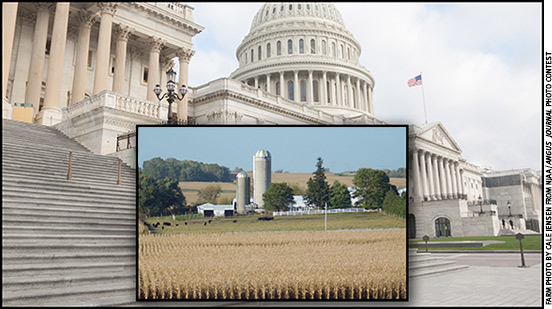
Current Farm Bill Defeated
2018 Farm Bill plans go back to the drawing board after a failure in the House of Representatives.
The House May 18 rejected the Agriculture and Nutrition Act of 2018 (H.R. 2), better known as the Farm Bill, by a vote of 198-213.
“We may be down, but we are not out,” said House Agriculture Committee Chairman Michael Conaway (R-Texas). “We will deliver a strong, new farm bill on time as the president of the United States has called on us to do.”
Lawmakers may take up a motion the following week, offered by House Speaker Paul Ryan (R-Wis.), to reconsider the Farm Bill. The legislation includes several provisions important to U.S. beef producers. Read more.
 Jake Troutt
Jake TrouttAssociation Perspective
Understanding the value of dollar indexes.
There currently are 28 expected progeny differences (EPDs) and dollar value indexes ($Values) available for producers to use when breeding quality Angus cattle. With so many traits to analyze, the paper can sometimes become a bit much to look at. There are indeed some herd sires that are superior across the board in all traits — curve benders, if you will. Read more.
Animal Health Contributes Billions to U.S. Economy
New study quantifies animal health industry’s economic and social contributions to the United States.
A comprehensive new study, “The Economic and Social Contributions of the Animal Health Industry,” documents the value and role that the companies that produce animal medicines play in the U.S. economy and beyond. The results are clear: In its work to improve the health of nearly 10 billion companion and food-producing animals, the animal health industry contributes significant economic and social benefits across America.
Fueled by $9.9 billion in sales of medicines, the U.S. animal health industry employs 21,257 workers, accounts for more than $1.2 billion in wages and $1.2 billion in taxes, and maintains a positive balance in trade. Read more.
U.S. Beef Industry Sustainability Updates
U.S. beef industry leaders release first-ever national framework for beef sustainability.
The U.S. Roundtable for Sustainable Beef (USRSB) opened a 60-day public comment period beginning May 3 on the group’s Sustainability Framework.
The USRSB Sustainability Framework is a set of resources developed to assist ranchers, cattle auction markets, feedyards, packers, processors, and retail and foodservice organizations in their efforts to continuously improve the sustainability of U.S. beef.
“The Framework was developed from the collective efforts of more than 200 individuals who make up the USRSB and represent all segments of the beef value chain from producers to retailers, including nongovernmental organizations and academic institutions,” said Kim Stackhouse-Lawson, JBS USA sustainability director and 2018-2019 USRSB chair. “The USRSB membership has invested more than three years in developing these resources, which we believe will serve as an invaluable tool in enhancing U.S. beef sustainability and increasing economic opportunities in rural landscapes across America.” Read more.
What’s Inside …
In this May edition of the Angus Beef Bulletin EXTRA, you'll find valuable articles devoted to the management, marketing, and health and nutrition of your beef enterprise. Select from the tabs at the top of the page to access this month’s entire offering by category. A few select features include:
- Don’t Let Fire Ants Ruin Your Summer
- Hauling After Breeding is Risky
- In the Cattle Markets: 2018 beef exports off to a strong start
- Biological Control of Invasive Weeds
- Poison Hemlock Risks
- Light Weights, Heavy Impact
- What is the Cost of Keeping an Open Cow?
- Cut Costs by Cutting BRD Re-treats
- Beef Producers Contribute to Societal, Economic Fabric of Kansas
News Briefs …
The American Angus Association and its subsidiaries generate a wealth of information to keep members and affiliates informed of what's happening within the industry, as well as with the programs and services they offer. Click here for easy access to the newsrooms of the American Angus Association and Certified Angus Beef LLC and the Angus Journal Daily archive available in the API Virtual Library.
![]()
Helping Farmers Out of Depression
Farmers, as an occupational unit, have the highest rate of suicide in the nation, according to the CDC.
The corn was dying that summer.
So were the soybeans, drying out and shriveling up. What was the point of spraying for pests? It was 1988, one of the worst episodes of drought across the United States. That was the summer a 52-year-old northwest Ohio farmer who had been worrying about losing his crops, woke up one July morning; put on a fresh pair of jeans, a crisp white t-shirt and white socks; walked into the farm building where he had fixed tractors and stored wheat; and took his life.
Even now, nearly 30 years later, his daughter-in-law, who is active in a support group for suicide survivors, struggles to think about it. She agreed to talk about his death while keeping her identity anonymous at the request of relatives who aren’t as open about it. Read more.
![]()
Struggling to Hear?
Tiny devices can keep you connected.
Many people slowly lose their hearing as they get older. Not being able to hear well can make it hard to communicate. That can affect your relationships, emotional well-being and work performance.
For those who need them, hearing aids can help. These electronic devices are worn in or behind the ears. They make sounds louder. Close to 29 million adults could benefit from hearing aids, yet only one in four has ever used one.
An exam of your ears, nose and throat might detect a physical reason why you’re not hearing as well. You may want to start by talking with your primary care provider or an ear, nose and throat doctor, also known as an ENT or otolaryngologist. Read more.






